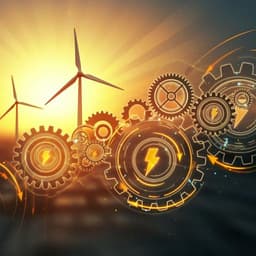
Environmental Studies and Forestry
Sustainability of emerging energy and transportation technologies is impacted by the coexistence of minerals in nature
A. Elshkaki
Explore how wind power and electric vehicles can improve air quality while uncovering the unseen environmental costs associated with rare metals extraction. This research conducted by Ayman Elshkaki delves into sustainability, carbon emissions, and the importance of material efficiency in clean energy technologies.
~3 min • Beginner • English
Introduction
The paper addresses how the sustainability of wind power (WP) and electric vehicles (EVs) is influenced by the natural co-occurrence and co-production of rare earth elements (REEs), particularly neodymium (Nd) and dysprosium (Dy), essential for permanent magnet technologies. While WP and EVs reduce CO2 emissions and air pollution, their reliance on REEs—often as companion metals with limited availability, concentrated production, and significant environmental burdens—can cause supply–demand imbalances. Increasing demand for target REEs (Nd, Dy) can drive oversupply of coexisting REEs (La, Ce, etc.) if their markets do not expand correspondingly. Conversely, technology shifts (e.g., Li-ion displacing NiMH batteries) may reduce demand for some REEs (La, Ce), exacerbating balance issues. The study seeks to quantify global supply–demand balance implications of coexisting REEs for WP and EVs, and the associated energy, water, CO2 emissions, and radioactive by-products, to evaluate long-term sustainability and mitigation options.
Literature Review
Prior work has identified REEs as critical due to supply risk, geographic concentration, and environmental impacts. Life cycle assessment (LCA) and energy system models (ESMs) often underrepresent minor metals and struggle with allocating impacts among coproducts, which complicates accurate assessment of emerging technologies. Studies have included coproduct fractions in criticality assessments and examined supply–demand balance for individual technologies (e.g., wind), but none quantified the broader co-extraction-induced oversupply of coexisting REEs across both WP and EVs and the resultant environmental implications. The paper builds on work highlighting REE production’s high energy, water, and emissions footprints and the methodological challenges of joint production and price volatility in LCA, arguing for mass allocation and system-level analysis.
Methodology
The study applies a global dynamic material flow-stock (MFS) model to quantify demand and supply of key REEs (Nd, Dy, Pr, Tb) in wind power (WP) and electric vehicles (EVs), and to estimate associated energy, water, CO2-equivalent emissions, and radioactive coproducts. Key elements:
- Demand scenarios: Two demand scenarios for REEs used in WP and EVs—High Demand (constant material content, MC) and Low Demand (decreasing MC). WP and EV trajectories follow IEA scenarios; EV stock extrapolated to 2050. Technology lifetimes assumed 20 years (WP) and 12 years (EVs). PMG share in WP rises to 50% by 2050. MC reductions by 2050: −55% for Nd and Dy in WP; −35% for Nd and Dy in EVs.
- REE demand in other sectors: Global end-use demand for individual REEs (magnets, alloys, catalysts, polishing, glass, phosphors, ceramics) is projected using 2017 baselines and sectoral growth rates, allocating to individual REEs by sectoral composition factors.
- Supply scenarios (primary): SSC1—supply from all global deposits; SSC2—targeting Dy-rich deposits. Supply of Nd, Dy, Pr, Tb equals their modeled demand; supply of other REEs is derived using deposit-specific ratios of each REE to the target metals, based on deposit ore composition and planned production (with REO-to-REE conversion factors). Global and deposit-level ratios are compiled from literature and project data.
- Supply scenarios (secondary/recycling): RSC1—partial Dy recycling (90% WP, 70% EVs) with no recycling of other REEs; RSC2—partial Dy recycling plus 30% recycling of other REEs. Recycling flows are computed from dynamic outflows of products.
- Supply–demand balance: Calculated as the difference between co-produced REE supplies (driven by Nd, Dy, Pr, Tb demand) and projected global demand for each REE.
- Environmental intensities: Energy, water, and CO2-eq intensities for REE production are primarily from Chinese LCA studies (Lee and Wen) with low/average/high ranges, adjusted for non-Chinese deposits per literature. Cumulative and annual impacts are computed for Nd and Dy production and for oversupplied REEs under demand, supply, and recycling scenarios.
- Radioactive coproducts: Thorium (ThO2) and uranium (U3O8) coproduct quantities are estimated using deposit-level ratios of Th and U to total REO and Dy to total REE, under both supply scenarios.
- Alternative sources: Ratios of other REEs per unit Dy are compared for traditional deposits versus coal, bauxite, and phosphate gypsum sources to assess supply–demand balance implications.
Key Findings
- Demand growth and composition:
- By 2050, Nd demand in WP+EVs reaches 348.3 kt (High D) vs 219.5 kt (Low D). In High D, Nd demand shares: WP 8.2%, EVs 91.8%; in Low D: WP 5.3%, EVs 94.7%.
- Dy demand in WP+EVs reaches 52.1 kt (High D) vs 33.1 kt (Low D). In High D, Dy demand shares: WP 7.7%, EVs 92.3%; in Low D: WP 5.6%, EVs 94.4%.
- Co-production and oversupply:
- 2050 annual total REE supply induced by Nd demand: 1388–2202 kt; induced by Dy demand: 2325–3660 kt (all scenarios).
- Nd demand would co-produce 19.8–31.4 kt Dy by 2050 (≈60% of Dy required), implying additional REE production to meet Dy demand, further increasing oversupply of other REEs.
- Dy demand co-produces 367.8–578.9 kt Nd by 2050, exceeding Nd needs in WP+EVs.
- Substantial oversupply of La and Ce: 323.9–513.9 kt La and 554.2–879.3 kt Ce by 2050 from Nd-driven supply alone.
- Environmental burdens of oversupply vs target metals:
- Cumulative impacts of oversupplied REEs (Dy-driven, high-demand cases): energy 1277–2565 PJ; water 1461–2883 million m³; CO2-eq 84.1–169.3 Mt.
- By 2050, annual impacts for producing Dy+Nd to meet WP+EV demand: energy 262.1–415.1 PJ; water 297–470 million m³; CO2-eq 17.2–27.2 Mt. Oversupply impacts are 4.9–6.2 times those of Dy+Nd production.
- By 2030, annual CO2 from Nd+Dy demand: 7.3–9.2 Mt; from oversupplied REEs: 45–61.5 Mt.
- Relative to IEA EV30@30 emission reductions: combined CO2 from REE demand+oversupply equals 22–29% of EV-only reduction (241 Mt), 19–26% of power decarbonization reduction (273 Mt), and 10–14% of the combined EV+power scenario.
- Radioactive coproducts (all deposits supply):
- Annual ThO2 by 2050: 43.14–67.5 kt (mainly Nolans 42%, Steenkampskraal 16%, Chavara 9.2%, Bayan Obo 7.5%, Strange Lake 6.7%).
- Annual U3O8 by 2050: 9.4–14.78 kt (mainly Kvanefjeld 59.3%, Nolans 14%, Strange Lake 10.2%, Dubbo 7%, Zandkopsdrift 4%).
- Dy-rich supply reduces annual ThO2 to 7.39–11.63 kt and U3O8 to 2.11–3.32 kt by 2050.
- Mitigation options and effectiveness:
- Recycling: Without recycling, cumulative oversupply impacts (energy 1277–2565 PJ; CO2 84–169 Mt; water 1461–2883 million m³). With Dy-only recycling (RSC1): 35–45% reduction (high/low demand). With Dy+other REE recycling (RSC2): 24–28% reduction.
- Resource efficiency (lower MC) and deposit targeting: Resource efficiency reduces energy/CO2/water by ~38/38.2/37.5%; Dy-rich deposits reduce by ~64.4/66/44%; combined reduce by ~75.6/76.7/61.6% (for totals of oversupply plus Nd+Dy). Abstract-level results indicate CO2 reductions of 78% (Dy-rich), 39% (efficiency), 35% (recycling), and 90% combined.
- Combining Dy-rich supply and recycling can reduce cumulative energy, water, and CO2 burdens by ~83.4%, 74.4%, and 84.3%; adding MC reductions yields ~90%, 84%, and 90% reductions, respectively.
- Alternative sources and balance problem:
- Per kg Dy produced, other REE co-production (kg/kg Dy): traditional deposits ≈69; coal 31.6; bauxite 44.5; phosphate gypsum 118.9. Coal and bauxite lessen oversupply ratios; phosphate gypsum worsens them.
- Broader co-production effects (example: Pb):
- Pb demand grows 110% (2020–2050). By 2050, secondary supply covers 58% of demand; primary 42%.
- Increased Pb recycling reduces primary supply by 29%; EV uptake reduces primary supply by 12%; combined 36%. Maintaining primary growth to secure companion metals with EV uptake would lower Pb recycling rate from 80% to 63%.
Discussion
The study demonstrates that evaluating the sustainability of WP and EVs requires accounting for all naturally coexisting REEs, not just those directly used. Demand for Dy (and to a lesser extent Tb in WP alone) drives substantial co-production and oversupply of other REEs such as La and Ce, generating environmental burdens (energy, water, CO2, and radioactive wastes) several times greater than those from the target metals themselves. These burdens meaningfully offset the net climate benefits attributed to EV deployment and, by extension, can affect system-level decarbonization outcomes if unaccounted for. Joint analysis of technologies that share material inputs (WP and EVs) is essential, as demand for one REE in a technology can cover or exacerbate demand for another through co-production. Mitigation strategies—resource efficiency lowering material intensities, targeted extraction from Dy-rich deposits, and enhanced recycling—can markedly reduce oversupply and its impacts, with combinations achieving large reductions. Alternative sources (coal, bauxite) may improve supply–demand balance ratios per unit Dy compared to traditional deposits, while phosphate gypsum may worsen them. The findings underscore the importance of integrating co-production dynamics and upstream manufacturing emissions into energy systems planning and LCA to avoid overestimating mitigation potential of clean technologies.
Conclusion
This work quantifies, for the first time at a global scale, how the natural co-occurrence and co-production of REEs affect the sustainability of wind power and electric vehicles. It shows that Dy-driven co-production causes significant oversupply of other REEs, with associated energy, water, CO2, and radioactive waste burdens that can offset a notable fraction of EV-related emissions reductions. The study identifies effective mitigation measures: reducing material intensities (resource efficiency), targeting Dy-rich deposits, and increasing recycling—individually and in combination—to substantially curb oversupply impacts. Future research should: (1) develop temporally and geographically explicit LCA data for REE production outside China; (2) refine integrated assessment and energy system models to incorporate co-production and allocation effects; (3) explore demand-side substitutions and design-for-recycling to lower critical REE use; (4) evaluate feasibility and impacts of alternative REE sources (coal, bauxite, phosphogypsum); and (5) examine cross-metal co-production interactions beyond REEs (e.g., Pb, Pt-group, Co, In, Te) under different electrification pathways.
Limitations
- Environmental intensity data are primarily from Chinese deposits with adjustments for other regions; detailed, deposit-specific LCA data globally are limited, and intensities are dynamic with ore grades, efficiencies, and energy mixes.
- Supply projections rely on currently operating and planned projects and assumed production shares; geopolitical and market changes may alter availability and impacts.
- Scenario assumptions (IEA WP/EV pathways, PMG market share, technology lifetimes, material content trajectories, and recycling rates) introduce uncertainty; more aggressive deployment scenarios would increase demands and oversupply.
- LCA allocation issues inherent to joint production remain challenging; mass allocation was used, but economic/value-based fluctuations could change results.
- Some modeled reductions and deposit ratios may vary with future technological advances, regulatory shifts, or discovery of new deposits or applications for oversupplied REEs.
Related Publications
Explore these studies to deepen your understanding of the subject.







